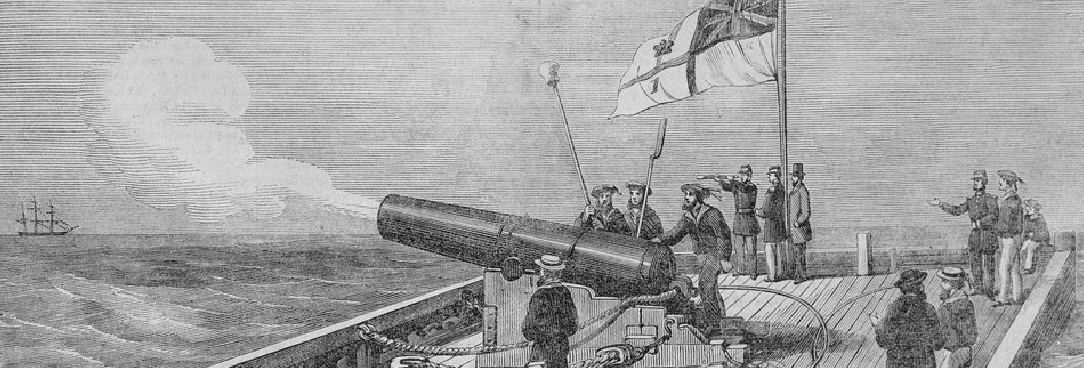Last updated:
The Crown and Kangaroo Victorian Flags, Provenance: The Journal of Public Record Office Victoria, issue no. 11, 2012. ISSN 1832-2522. Copyright © John Rogers.
The current Victorian flag with the Union Flag and crown above a Southern Cross originated from the 1877 Victorian flag with a different crown. The 1877 flag was itself a variation on the 1870 flag which did not include the crown. This article presents the evidence for the existence of two earlier forgotten Victorian flags, which intriguingly included a kangaroo in their design.
After separating from New South Wales in 1851, the colony of Victoria lacked a distinctive flag to fly from its vessels. It has previously been believed that this state of affairs continued until 1870 when a Victorian flag became available. The research detailed below indicates that two types of official Victorian flags were in use prior to 1870. It would appear that history had simply forgotten about them.
Inauguration of the Victorian Flags in 1870
On 9 February 1870, Her Majesty’s Victorian Ship (HMVS) Nelson and the Reformatory Ship, Sir Harry Smith fired a 21-gun salute. The occasion was the unfurling of the new blue Victorian Government flag and new red Victorian merchant flag on board the ex-Line-of-Battleship HMVS Nelson. Described by the Argus newspaper as an event of some importance,[1] the Naval & military gazette pointed out that the new (government) flag was ‘adopted at the suggestion of the Admiralty to distinguish the vessels of the Victorian Navy’.[2]
This 1870 Victorian flag was very similar to the current Australian flag. Naturally, being prior to Federation, the 1870 flag did not include the Federation star and, unlike the current Australian flag, the stars of the Southern Cross on the Victorian flag had, and still have, five, six, seven, eight and nine points. The 1870 flag soon evolved into the 1877 flag when the size of the Southern Cross was reduced and an imperial crown added above it. The Victorian flag changed again in 1901 when the Imperial crown was replaced by the Tudor crown which was itself replaced by the St Edward’s crown in 1953, thereby creating the current Victorian State flag.
1865 Victorian Flags
In all of the coverage of the inauguration of the 1870 Victorian flags, no mention was made that the colony of Victoria already had a flag. While researching Victoria’s Colonial Navy I came across a fascinating engraving of the Victorian Navy’s gun raft, known as The Elder.[3] Of particular interest in the engraving was the flag being flown by the gun raft.
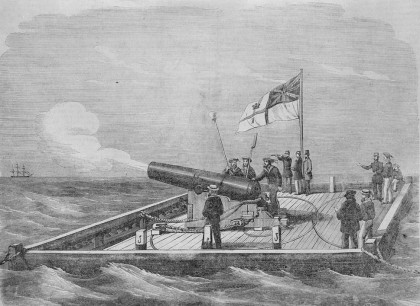
The Victoria Government gazette of 27 January 1865 described the new flag for Her Majesty’s Ships of War as ‘shall bear a white ensign, with a red St. George’s cross and the union in the upper canton’.[4] This item referred to ships of the Royal Navy and was for general information only.
Clearly the Victorian Government was inspired by and acted on this gazetted information and used the new British white ensign as the basis for its own new flag. In the Victoria Government gazette of 12 December 1865 it was stated that ‘in accordance with the Admiralty Regulations, published in the Government Gazette of the 27th of January, 1865, the Blue Ensign with the Union described therein, together with a Crown and the initial letter H.M.C., will be borne by boats, &c., in the Customs Department, in lieu of that previously in force’.[5]
If the initials HMC indicate a practice of using initials to indicate that Her Majesty’s Customs Department controlled the vessel, then the hard to distinguish letter on the gun raft flag of 18 February 1865 could be the letter T. This would make sense, as the Treasury Department controlled the Victorian Navy until the establishment of a Defence Department in the 1880s.
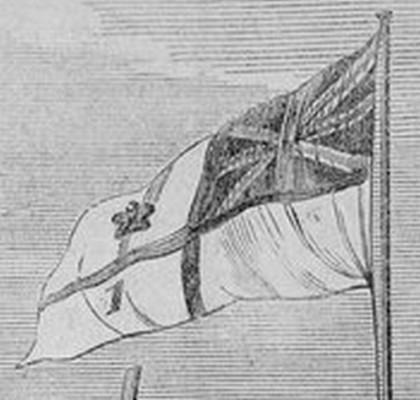
The reason that the blue ensign was adopted was an instruction from Downing Street stating that, following from the circular despatch of 19 May 1865 containing a copy of the Colonial Naval Defence Act 1865, the Lords Commissioners of the Admiralty instructed ‘That any vessel provided and used under the 3rd section of the Colonial Naval & Defence Act should wear the blue ensign with the seal or badge of the colony in the fly thereof, and a blue pennant.’ The instructions further stated that non-defence government vessels ‘should wear a similar blue ensign, but not the pennant’.[6]
While debating the Murray Customs Bill in the South Australian House of Assembly in 1866, the question of the use of the image of an emu on the South Australian flag arose. The South Australian Treasurer, Mr Walter Duffield, stated ‘the emu was adopted because, as he had stated before, the kangaroo and emu were recognised as the arms of Australia, and the former had been adopted for the Victorian flag’ (emphasis added).[7]
Yet another reference to the kangaroo image being used on the Victorian flag appears in 1867 when a correspondent named Weather-Gage wrote, ‘In Victoria, the colonial sloop of War, the “Victoria,” flies the Blue Ensign, with a kangaroo in it…’.[8]
A third reference to the crown and kangaroo flag appears in Ian MacFarlane’s unpublished manuscript regarding the royal visit of Prince Alfred to Victoria in 1867. He writes, ‘In 1867 the Victoria and Naval Training Ship hoisted blue ensigns with a crown and kangaroo design’.[9]
It was during this 1867 royal visit by Prince Alfred that Her Majesty’s Colonial Ship (HMCS) Victoria was photographed with the crew having ‘dressed ship’ and manned the yardarms. Victoria is shown flying the Union Flag from the bow, the pre-1864 British Red Naval Ensign from the foremast, the post-1864 British White Naval Ensign from the main mast and the Victorian Naval Ensign from the stern. A copy of this photograph was hand-tinted at the time and presented to HMCS Victoria’s captain, Captain Norman. That the tinted photograph survives in the hands of Captain Norman’s great-grandson is extremely fortunate. Given that the original dimensions of the photograph are 355 mm x 204 mm, the size of the Victorian Ensign of 20 mm x 10 mm is not going to hold a lot of detail. Clearly the tinting of the flag was not intended for future researchers to definitively identify elements of the flag. On its own the image of the flag is not sufficient evidence for identification purposes. However, taken with the preceding information the tinted flag does allow us to confirm that the animal that we know to be a kangaroo is standing erect rather than squatting or leaping, is coloured yellow, and is under what we know to be a crown. What is missing from this flag is the St George cross which was mentioned in the 1865 Victoria Government gazette. Perhaps the cross was only used on the department flags and not on flags flown by Captain Norman’s ‘executive ships’, as mentioned later in this article. In any case the St George cross is missing from both the 1867 coloured photograph and from an uncoloured copy of the photograph held by the National Library of Australia.[10]
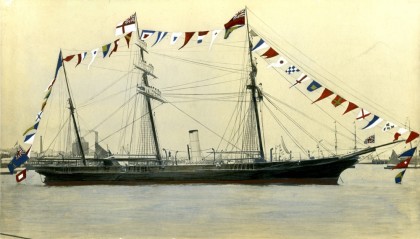
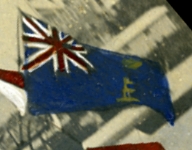
As mentioned earlier, the 1877, 1901 and 1953 Victorian flags featured different crowns which related to the monarch of the day. Given that the 1877 flag featured the Imperial crown used by Queen Victoria[11] it is reasonable to assume that, as the 1856 and 1865 flags were created during Queen Victoria’s reign, the style of crown that they would have incorporated would also have been the Imperial crown.
On the departure of Prince Alfred from Victoria in 1868, his ship, HMS Galatea, was described in the Launceston examiner as flying different flags from her three masts: ‘… the Galatea, by this time carrying the Victorian ensign (we believe we have named it properly) at her fore, the Royal Standard at her main, and the white ensign at her mizen [sic]’.[12] In the engraving of HMS Galatea below, the Royal Navy’s white ensign can be seen flying from a line attached to the mizzenmast (mast near the stern) and the Victorian ensign flying from the foremast. Apart from the St George cross, the artist or the engraver has omitted any details from the Victorian ensign. A comparison of the two ensigns with the shading on the Victorian ensign, and the gun raft flag, suggests that the blue mentioned in the Victoria Government gazette may have been, unlike in the tinted photograph, actually a light blue.
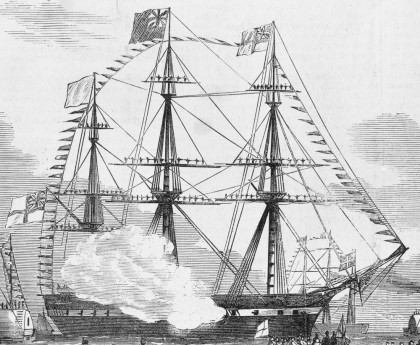
1856 Victorian Flags
On consulting Ian MacFarlane, an expert on the early Victorian Navy, about the gun raft flag, I was advised that Public Record Office Victoria held correspondence regarding a proposal for the various government departments to fly flags on their vessels. These flags were to bear initials so as to indicate which department controlled each vessel.
Although simply seeking further information on the 1865 flags, an examination of three documents and associated notes held by PROV, as well as information on 12 December 1865 in the Victoria Government gazette, specifically the phrase ‘in lieu of that previously in force’, revealed that there was an even earlier flag than the 1865 design.
On 28 September 1856, Captain William Henry Norman of HMCS Victoria wrote to the Victorian Chief Secretary (Premier William Clark Haines) regarding the Chief Secretary’s desire to distinguish the various departments’ operating vessels by having them fly distinctive flags.[13] This proposal was initiated by the Chief Harbour Master, Captain Charles Ferguson, who had recommended on 11 September that, when on active duty, government vessels should fly distinguishing flags bearing initials so as to indicate to which department they belonged, such as was already the case with customs vessels.[14] In a letter from the Office of Trade and Customs dated 19 September it was pointed out that the letter V was to be used for HMCS Victoria, W.P. for Water Police vessels such as the Blockship, Sir Harry Smith, P.D. for ships of the Penal Department such as the prison hulks, and H.O. for the Health Officer’s boat. Unfortunately no mention was made of the initials already in use by the Customs Department.[15]
Captain Norman disagreed with the proposal that his ship, HMCS Victoria, should have the letter V added under the crown on the flag. In his letter of 28 September he argued that only ships belonging to civil departments such as Customs and the Harbour Master should have distinguishing letters on their flags.[16] It was the practice in Her Majesty’s service, and in the governments of other colonies, for vessels which received their orders directly from the head of government not to have letters, as they were considered Executive Ships.
Frustratingly, in spite of Charles Ferguson’s stated intention of ‘defining the description and colour of flags they (Government vessels) are to hoist’, the exact nature of the intended flags is not known. We know that the flag bore a crown. It is reasonable to assume that there was a Union Flag in the upper canton (as on the Australian and later Victorian flags). The only other hint is in Captain Norman’s letter where he states that ‘I therefore beg to suggest that as the “Victoria” has the Honor of being the first “War” Steam Sloop belonging to this, and in these Colonies – and will be expected to do the customary honors to the flag of any of H.M. officers that may visit the Colony by flying the same Colored flag …’. As the red ensign was the main ensign of the Royal Navy until 1864, particularly of visiting ships, it is likely that Captain Norman was referring to the Victorian Naval Ensign as also being red.
What is even more fascinating in Captain Norman’s letter is that, before he made the case for not including the letter V on his ship’s flag, he wrote the following.
Before going to [the] expense of making the alteration having the ‘Kangaroo’ in the position named for the letter, I beg most respectfully to bring to your notice what is customary in Her Majesty’s Service, and the Governments of other colonies.
He then went on to argue his case against the use of the letter V. However it is the reference to the inclusion of a kangaroo image on the flag that is of interest here.
It appears that Captain Norman had decided to place an image of a kangaroo under the crown but was holding off on doing so until the letter V issue was sorted out. The notation signed by JM (possibly Assistant Colonial Secretary John Moore) that ‘The letter V be dispensed with’ indicates that there was indeed room for the kangaroo image below the crown. Unfortunately, the Chief Secretary’s reply, dated 10 October 1856, that ‘The request of Captn. Norman may be complied with’,[17] although suggesting that Captain Norman was free to proceed with his design, does not specifically mention that a kangaroo image was adopted. If only records always covered the points that we wanted to them to cover, research would be a lot easier!
A further letter dated 18 December 1856 regarding payment of £9-0-10 for flags for the ship Victoria gives no details,[18] and as it was for Major-General Edward McArthur’s trip to Geelong, could possibly refer to pennants rather than flags.
When HMCS Victoria left for her second trip to New Zealand on 24 July 1860 carrying more members of the 40th Regiment of Foot, the Argus stated that ‘… there was a pervading feeling of gratification that a British general officer and his staff should take his departure under our colonial flag …’.[19] That the colour of Victoria’s colonial ensign was red is clear from the Herald newspaper’s report of the same event, which stated ‘… the Victoria moved slowly away, St. George’s ensign at the fore, the red ensign at the main, and the Governor’s flag at the mizen [sic] …’.[20] The Victorian Navy’s first of its two overseas campaigns, known as the First Taranaki War, was at least partly conducted under the 1856 Victorian Ensign. The only known image of Victoriain New Zealand is a contemporary watercolour by Edwin Harris in the Puke Ariki Library and Museum, New Plymouth. This painting, also on the cover of Ian MacFarlane’s book, Victoria and Australia’s First War,[21] shows HMCS Victoria landing a detachment of the British 40th Regiment of Foot and flying only the Union Flag. That Victoria’s departure on 24 July was her second trip to New Zealand indicates that she had not stopped flying the Victorian Ensign during the First Taranaki War and that it was either flown all of the time that she was in New Zealand or, if the painting is accurate, at the least when away from New Zealand.
On her return from New Zealand in 1861, HMCS Victoria, under Captain Norman, travelled to the Gulf of Carpentaria in search of the Burke and Wills expedition. On the banks of the Barkly River, Captain Norman caused a flag to be raised as a signal to the missing explorers.[22] Whether he raised the Victorian or Union Flag is not mentioned. It would appear that the explorers being searched for did use a Victorian flag. At least two poems of the day refer to Burke and Wills travelling to the Gulf of Carpentaria with the Victorian flag.
‘Burke and Wills’ by ‘M.M.E.’ (third verse)
They travalled [sic] o’er the desert wild,
Victoria’s flag they bore,
And rested not until they gazed
On Carpentaria’s shore.[23]Poem by ‘J.’
Mourn for the brave heroic souls who bore
Victoria’s flag to Carpentaria’s shore,
Achieved the object of their country’s pride,
And, left to fate by bungling savans, died.[24]
While in the Gulf of Carpentaria, the brig Firefly was placed under the command of Captain Norman. A painting of the Firefly on the Albert River, labelled ‘The Victorian Naval Depot, by Lieutenant GA Woods V.N.’ shows Firefly flying a red ensign. Unfortunately there is no detail on the fly (body) of the flag. The 1856 red ensign was certainly travelling around Australasia. Another painting of HMCS Victoria on Ian MacFarlane’s website shows Victoria flying a red ensign with a hint of yellow on the fly of the flag.[25]
Conclusion
By examining the letters preserved at PROV, reports in newspapers and government publications of the mid-1800s, and photographs, engravings and paintings of the same time, we now know that Victoria had two colonial flags prior to the previously known 1870 and 1877 colonial flags and the two Victorian 1901 and 1953 State flags. Not only do we now know that 1856 and 1865 Victorian flags existed, but we have a reasonably good idea of their appearance.
Endnotes
[1] The Argus, 10 February 1870, p. 5.
[2] Naval & military gazette, 30 April 1870.
[3] The illustrated Melbourne post, 18 February 1865.
[4] Victoria Government gazette, item of 27 January 1865, p. 189.
[5] Victoria Government gazette, item of 12 December 1865, p. 2888.
[6] Debates in the Houses of Legislature during the third session of the fourth Parliament of South Australia, Andrews Thomas & Clark, Register & Observer Offices, Adelaide, 1867, 1 November 1866, column 839.
[7] ibid., column 837. In all of the quoted passages below, the highlighting has been added by the author.
[8] Bell’s life in Sydney and sporting chronicle, 29 June 1867 p. 3.
[9] I MacFarlane, ‘Victoria: a history of HMCSS Victoria’, unpublished manuscript, private collection, p. 195.
[10] Australian War Memorial, Her Majesty’s Colonial Steam Ship “Victoria”, Photograph, Black & white – Film original negative 5×4″ safety base, item no 300060.
[11] PROV, VA 672 Premier’s Office, VPRS 1163/P8 Inward Correspondence Files 1945-1971, Unit 1, 45/592 Seals, Flags, Arms, Badges etc.
[12] Launceston examiner, 11 January 1868, p. 2.
[13] PROV, VA 475 Chief Secretary’s Department, VPRS 1189/P0 Inward Registered Correspondence 1, Unit 690 Customs (includes some Harbour Master), Item W56/8028.
[14] ibid., Item W56/8028, Harbourmaster Ferguson letter dated 11 September 1856.
[15] ibid., letter from the Office of the Commissioner of Trade and Customs dated 19 September 1856.
[16] ibid., Unit 579 Naval 1856- , Item X56/8282, letter from Captain Norman dated 28 September 1856.
[17] ibid., annotation on cover sheet, signed by WHC [presumably William Clark Haines the Chief Secretary] dated 13 October 1866.
[18] ibid., File Y56/10531 ½.
[19] The Argus, 25 July 1860, p. 5.
[20] The Herald, 25 July 1860, p. 4.
[21] I MacFarlane and N Smith, Victoria and Australia’s first war, Mostly Unsung Military History Research and Publications, Brighton, Victoria, 2005.
[22] See Commander William Henry Norman’s Journal (‘Report of Commander Norman of H.M.C.S.S. Victoria, together with copy of his journal of the late expedition to the Gulf of Carpentaria’), available on the Burke & Wills online digital archive (accessed 20 August 2012).
[23] The Cornwall chronicle, 26 July 1862, p. 2.
[24] The South Australian advertiser, 13 November 1861, p. 2.
[25] See watercolour sketch, late 1850s?, on Defending Victoria website (accessed 14 September 2012).
Material in the Public Record Office Victoria archival collection contains words and descriptions that reflect attitudes and government policies at different times which may be insensitive and upsetting
Aboriginal and Torres Strait Islander Peoples should be aware the collection and website may contain images, voices and names of deceased persons.
PROV provides advice to researchers wishing to access, publish or re-use records about Aboriginal Peoples
